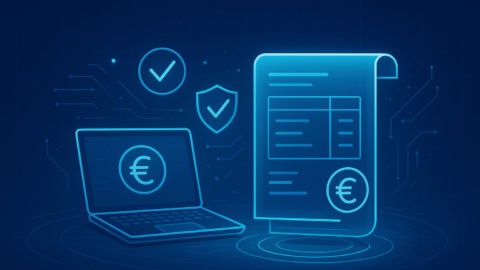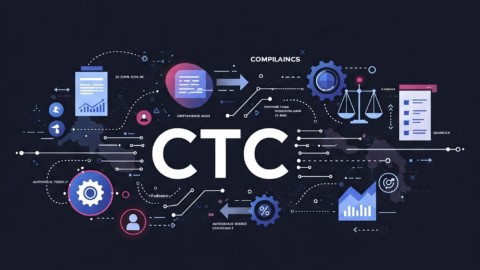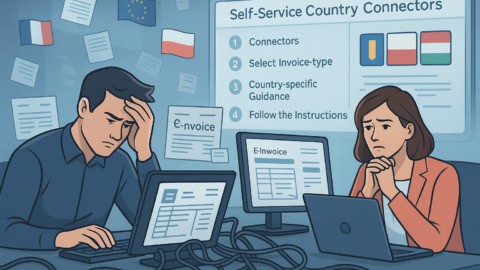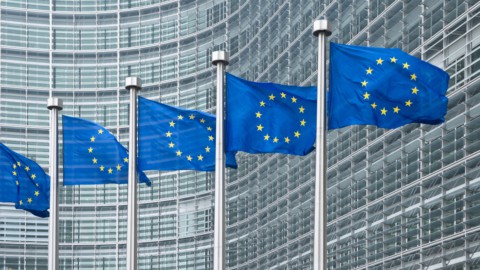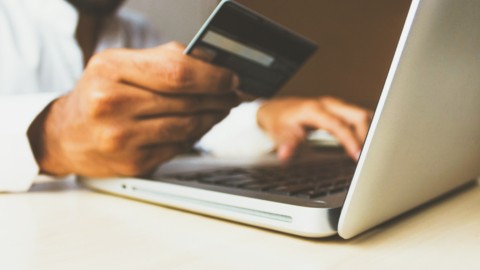Over the past few years B2B invoicing has been undergoing a profound transformation. Across Europe and beyond there has been a notable shift away from manual invoicing processes towards more sophisticated, automated systems. In the space of just a few years e-invoicing has become the norm and is now viewed as virtually essential for any company that wants to stay competitive in modern supply chains.
Given the technical complexity involved in setting up and managing e-invoicing in-house, it’s no surprise that more and more businesses are opting for external invoicing solutions. But how do these work, and what benefits do they offer? In this article we’ll answer these questions and more, delving into the various factors shaping the current invoicing landscape and the pivotal role played by external invoicing solutions.
The shift towards e-invoicing
Since the 2014 EU Directive (2014/55/EU) in which the European Parliament unveiled its plan to make B2B e-invoicing mandatory across Europe, there has been much discussion and debate around invoicing. While few would disagree that the initiative is a logical step to reduce VAT fraud, and one that will ultimately benefit governments and businesses alike, many businesses are struggling to implement the necessary changes to their internal systems. Simultaneously, compliance deadlines are constantly being postponed and amended as governments recognise the scale of the shift they are mandating.
Regardless of specific deadlines, however, it remains true that e-invoicing is soon to become the new normal in all business transactions. The question is thus not should you transition to e-invoicing, but how best to do so.
Before we explore the two main options available to businesses, however, let’s first look briefly at the potential benefits that a successful e-invoicing solution can deliver compared to traditional methods.
The positives of e-invoicing
Time and cost savings
As opposed to PDF and paper-based invoicing, electronic invoicing is much more efficient. Not only is transmission instantaneous, the need to manually extract and input data is also completely eliminated on both sender and receiver’s side. As a result, individuals who would otherwise have been tasked with data entry can focus on more valuable tasks.
Faster transactions
Invoice payment periods typically begin from receipt of the invoice. Naturally, faster transmission will result in faster payment!
Fewer errors
As e-invoicing isn’t reliant on manual effort, the potential for human error to creep in is virtually non-existent. If the e-invoicing connection is sufficiently tested before go-live, errors should be extremely rare.
Simpler archiving
In compliance with legal mandates, businesses are obligated to retain invoices for potential tax audits, with the retention period varying by country (typically 5 to 10 years). Traditional paper invoices pose challenges for long-term storage due to susceptibility to fire/water damage. The repercussions of such incidents can be expensive, as tax authorities often resort to generous estimations. By contrast, e-invoices can be seamlessly integrated into electronic archiving systems, where backups and data mirroring can be utilised to ensure the security and accessibility of invoice data. What’s more, locating relevant records is much simpler!
Better partner relationships
Given the growing importance of e-invoicing across all industries, having an efficient and reliable e-invoicing system is something that businesses are increasingly looking for in new partners. As a result, the ability to meet partners’ EDI and e-invoicing requirements quickly and easily can provide businesses with a significant competitive advantage and improve existing relationships.
In-house vs external invoicing
When it comes to handling invoices, businesses essentially have two options: manage internally or outsource to an external provider. Which is best for you will depend largely on your internal resources.
Traditional paper/PDF invoicing involves a lot of manual tasks (e.g. extracting and inputting invoice data) and thus requires significant time investment from relevant individuals. With e-invoicing, however, thanks to the increased automation it provides, the key isn’t having a large team, but rather having people with the necessary technical expertise.
When it comes to handling e-invoicing in-house, there are two common errors that businesses make:
-
Assuming existing team members can manage the work. While your team may have been extremely efficient at traditional invoicing processes, this doesn’t mean they’ll be able to handle the complex mapping and routing tasks that are required for establishing e-invoicing connections. Moreover, when errors occur, it is important to be able to identify and correct them quickly, which again requires technical expertise.
-
Relying on one or two individuals. If you do have one or two individuals with e-invoicing expertise in the team, it may seem like there is no problem. However, being so reliant on these team members comes with significant risk. Should the individual(s) in question become sick or leave the company for some reason, you will find yourself in a very sticky situation. Further, if and when large projects come around, having limited internal expertise will result in issues.
For those businesses not confident in their capacity to manage e-invoicing internally, external invoicing solutions offer a helpful alternative. In such solutions all related tasks are handled by your provider, from the initial technical setup right through to ongoing monitoring of the connection and update installation. With this approach, internal teams are free to focus on what they do best, safe in the knowledge that connections are secure and transmissions compliant with the latest legislation.
The other key benefit of using an external provider is the flexibility it offers. Should you need to onboard multiple new partners suddenly, or expand into different geographical regions, this is no issue. Whereas changes such as these can be a serious headache to manage internally, and often end up delaying larger business projects, they can be sorted quickly with an external invoicing partner.
What to look for in an external invoicing provider
Choosing the right external invoicing provider is pivotal if you are to leverage the many benefits of e-invoicing. In order to make a successful selection, there are many things you should consider. These include…
-
Expertise: A good experienced external invoicing provider should have in-depth knowledge of e-invoicing laws and regulations across various jurisdictions. This is essential if they are to ensure your solution is compliant with current legislation. Once external experts are handling your invoicing tasks for you, there’s no need to worry about compliance issues or missing deadlines.
-
Technological capability: While it may be difficult for those who aren’t familiar with e-invoicing, it’s still important to investigate the technological capabilities of your future e-invoicing provider. This includes evaluating the platform’s features, scalability, and compatibility with your existing systems. Do they offer API integration? Can relevant data be easily accessed by internal teams when necessary?
-
Disruption minimisation: When choosing an e-invoicing provider, consider their ability to ensure minimal disruption to your current business setup. A seamless transition is essential for maintaining operational continuity. Asking for case studies can be helpful here.
-
Security: As security is paramount in e-invoicing, be sure to assess your proposed provider’s security measures to protect sensitive financial data. Do they operate a redundant infrastructure? Do they offer message archiving?
-
Quality of support: While virtually every solution offers support of some description, the quality of support varies hugely from one invoicing service provider to another. With this in mind, it’s worth asking detailed questions about how your proposed provider would deal with specific issues. Do they offer each customer a dedicated support contact? If not, calling their support line (where possible) may also be a good way to check how easy it is to speak to someone.
-
Flexibility: Given the pace at which regulations are changing, it’s essential that your provider is able to react quickly and implement the necessary updates. Your invoicing requirements will also naturally evolve over time, and it’s important that your chosen provider can adapt your solution quickly to suit your changing needs, so that invoicing processes never become a bottleneck.
By prioritising these three qualities when selecting an external invoicing provider, you’ll get more than a service. You’ll end up with a strategic invoicing partner that actively contributes to your long-term success.
Conclusion
With e-invoicing rapidly becoming the norm across Europe and beyond, it’s no surprise that more and more organisations are leveraging the help of external invoicing solution providers. As requirements become increasingly technical and convoluted and business partners demand more granular data from one another, handling invoicing in-house is becoming less and less viable for many businesses.
Thankfully, external invoicing solutions offer a simple answer for those businesses lacking the necessary internal expertise. Not only do such solutions allow businesses to enjoy all the benefits of e-invoicing (from cost and time savings to reduced risk and improved partner relations), they also provide extreme flexibility, ensuring that updating invoicing processes never becomes a handbrake.
Ultimately, businesses that recognise the significance of the recent shift towards automation and the potential of “as-a-service” solutions will be better equipped to navigate the complexities of modern invoicing requirements and position themselves as leaders in their respective industries.
Find out more
For more information on ecosio’s unique E-invoicing as a Service solution and how it could help you to make invoicing effortless, get in touch today. We’ve helped hundreds of businesses to transform their B2B integration processes and would love to help you do the same!
Want to stay up-to-date with e-invoicing news?
Sign up to our bi-monthly newsletter and get a rundown of recent e-invoicing developments, plus useful e-invoicing assets straight to your inbox.




